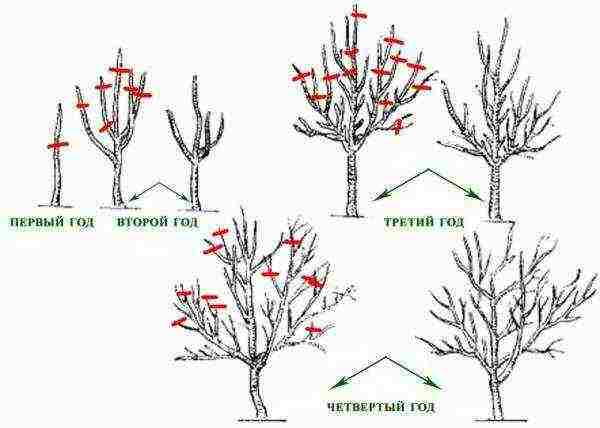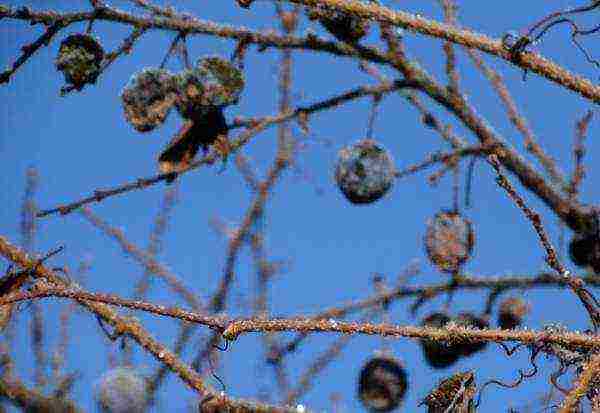Content
Plumlike any fruit crop, needs crown formation... Booking is an art akin to architecture. Developed spatial thinking is required from the gardener, as well as knowledge of plant physiology.
Before approaching a tree with a pruner, you need to understand well the meaning and purpose of your actions and know pruning techniques.
Plum, especially young, is an extremely fast growing plant... In one spring-summer season, she is able to expel such a number of shoots that it “crumpled” beyond recognition.
This is not good not only from an aesthetic point of view. On an unkempt crown, the fruits become smaller, ripen longer, and are more often affected by moniliosis and moth. The cold resistance of the plant decreases.
That's why a plum sapling must be nurtured from planting.
Depending on the purpose, there are five types of pruning of fruit trees:
- Formative... The goal is to design the crown of the plant.
- Regulatory... The goal is to maintain a satisfactory condition.
- Rejuvenating... The goal is to restore the fruiting of an old tree.
- Restorative... The goal is to eliminate dry and broken branches.
- Sanitary... The goal is the elimination of sick and pest-affected shoots.

Regardless of the purpose, usually three techniques are used when pruning plums:
- Ring cut... In this way, the unneeded branch is completely removed. At the same time, it is cut off not flush with the trunk, but along the border of the annular thickening at the point of attachment of the shoot.
- Kidney cut... It is used when you need to shorten the shoot and set the direction of growth. A good live kidney is selected in the desired position, and the excess part is removed with a pruner. It is important to do this strictly at a 45⁰ angle so that the upper edge of the cut is in line with the apex of the kidney.
- Transfer to side escape... This is a technique for a radical change in the direction of growth and rejection of unproductive branches. For this, the most promising one is selected from the lateral shoots and a cut is made 2-3 mm above the place of its attachment ("rings").
To be successful, you need the right set of tools. The must-have list includes a pruner, a delimber, two garden hacksaws (large and small), a good garden knife, a stepladder and a garden pitch.
Plum crown formation:
What time can you cut plums in spring and autumn, terms
Having dealt with the theoretical foundations of crowning, you can find the right time for pruning plums.
Most often, these procedures are carried out in spring and autumn... The specific type of work and some nuances will depend on the age and condition of the tree.
| Spring | |
| The ideal time for active interaction with trees is the beginning of spring. During this period, the plants are easier to tolerate "surgical interventions", and receive an incentive to lay flower buds. The exact timing of spring pruning varies by region. You need to navigate by the weather and by the development of the kidneys. The best moment is when the frosts have already receded, but the buds have not yet begun to swell. |
|
| Types of jobs | Young plum | Old plum |
|
|
| Autumn | |
| Autumn pruning of plums is done in September or early October, depending on the region. The exact time is determined by its own tree: as soon as the plum has dropped its leaves, you can work with it. | |
| Types of jobs | Young plum | Old plum |
|
|
You cannot do sanitary and other types of circumcision with the same instrument. After removing diseased branches, it is necessary rinse with fungicide solution or alcohol... Then wipe thoroughly with a clean cloth.
To cut or not to cut branches in the fall?
There is no consensus among gardeners about the advisability of autumn hacksaw manipulations. On the forums you can find, for example, such reviews:
“Before winter, my grandfather cut off all the trees in the garden, except for the plum. As I understand it, pruning plums in autumn increases the likelihood of freezing. "
"If there are severe frosts in winter, the cut plant can get frostbite and necrosis in this area."
Really, in the fall, you need to very carefully intervene in the life of the tree... Autumn cuts and cuts do not heal well. This is due to the physiology of the plant.

The healing of wounds in the tree is due to the growth of cambium. Cambial cells are actively dividing, forming an influx around the wound - callus. The growth of cambium occurs in the spring-summer period, and gradually stops in the fall.
If you don't guess the time and cut the plum late, the risk of infection increases significantly and desiccation of the wound surface. The plant leaves in winter weakened and does not tolerate frost well.
Therefore, if some procedure can be postponed until spring, it is better to leave your plum alone. Mandatory manipulation is only sanitary pruning of a diseased tree and the elimination of broken off branches.
How pruning is done in other seasons: summer and winter
It is better not to touch some fruit crops in the summer with pruning shears. Plum, on the contrary, is favorable to summer pruning.... It is better to plan the "haircut" in June.
You can do the following at this time:
- remove frozen shoots unnoticed in spring;
- to remove fatty shoots (the so-called "tops"), which the plum likes to expel.
We bring to your attention the following publications:
- Effective control of aphids on plums and other fruit trees.
- Why doesn't the plum blossom and bear fruit, and what to do about it?
- When and how to properly collect plums from a tree?
This accomplishes two goals: stopping the spread of disease in the garden and reducing the need for extensive sanitary pruning in the fall.
In recent years, gardening practice has increasingly included winter pruning plum... It is more correct, of course, to call it winter-spring, because this procedure is carried out closer to the end of February or at the very beginning of March.
Winter pruning is becoming more common due to the general instability of the climate, to which the plum tree can react with early awakening.
In winter, they carry out all the usual spring types of trimming.... This period has its own plus: while the cambium has not started to grow, the bark adheres more tightly to the wood, and there is no need to be afraid of bending and tearing it.
Winter pruning of plums is carried out only in regions with mild winters. The tree must not be injured if there is a risk of persistent frost return.
Spring pruning of plums and cherry plums:
Trimming techniques and schemes
To book the plum correctly, you need to imagine what a well-groomed plum tree looks like... If the variety is not columnar, then it will be a neat tree, with one central conductor and 4-5 skeletal branches arranged in tiers.
The diameters of the tiers decrease - the lower ones are larger than the upper ones. Skeletal branches do not deviate from the trunk at an acute angle. The crown is not thickened, the shoots grow on the outside, not inward.
Having built in mind the "project" of the future tree, you can begin to form it.
Post-plant pruning of young plum
Annual plum "babies" do not branch yet, therefore, it is better to start raising your tree from this age. You just need to determine the growth of the future plum and cut the stem at the desired height.
To obtain a compact tree, it will be enough to leave 1-1.2 meters above the ground.
Two-year-olds already have side shoots... It is necessary to inspect the seedling, check if the center conductor is cut. If not, it is shortened to the optimum height.
Then, from the remaining lateral increments, the most developed are selected. They are shortened by 25-30 cm from the trunk. These are skeletal branches, the future frame of the crown... The cut is made on the lower bud so that the branch does not develop upwards, but sideways.

Forming from the age of 3
On a three-year tree, skeletal shoots are already branching well. You need to work with them like this:
- Cut the apical growths to a length of 30 cm.
- Lateral - up to a length of 15 cm.
All sections are again made on the lower kidney.... The goal is to set the direction of growth of the shoots outward. In this case, the crown will be light, not thickened, each branch will receive a sufficient amount of sunlight.
This form is one of the most convenient. Taking care of a tree formed in this way is not difficult. In the future, he only needs regulating pruning. This type of work must be carried out annually so that the tree does not overgrow.
If you take care of the formed drain constantly, you will have to use the file only in case of emergency. Basically, you can get by with simple chasing with pruners.
Any cut is an open wound on the body of a tree.... It needs to be sealed with garden varnish. It will protect the plant from drying out, infection and gum removal.
Pruning young plums:
To rejuvenate an old tree
Most plums yield in about 15-20 years.... You can prolong fruiting, you can rejuvenate the plum if you make a rejuvenating pruning of the tree in time.
This is done from top to bottom according to the following scheme:
- The height of the crown decreases... For this, the upper skeletal branches are cut to the desired length and transferred to good lateral shoots that grow outward. In a particularly neglected case, you can cut the uppermost skeletal branch "into a ring" to relieve the center and lighten the crown.
- Removing thickening shoots... These are all directed towards the center of the crown, or woven with each other. At the same time, dry, weak and spoiled branches are removed.
- Removing hanging shootscoming from the trunk or branches of the lower tier.
- Shortening skeletal branches, transferring growth to good lateral shoots directed outward.
- Removing unnecessary "tops".

Plum is very difficult to heal wounds with a diameter of more than 5 cm... Therefore, you should not make several large cuts at one time.It is better to split the anti-aging procedure into several "sessions" at intervals of a year.
As a bonus, he will receive not only decent harvests and a healthy garden, but also additional space on the site. A well-groomed plum takes up much less floor spacethan growing unattended, and brings aesthetic pleasure.


